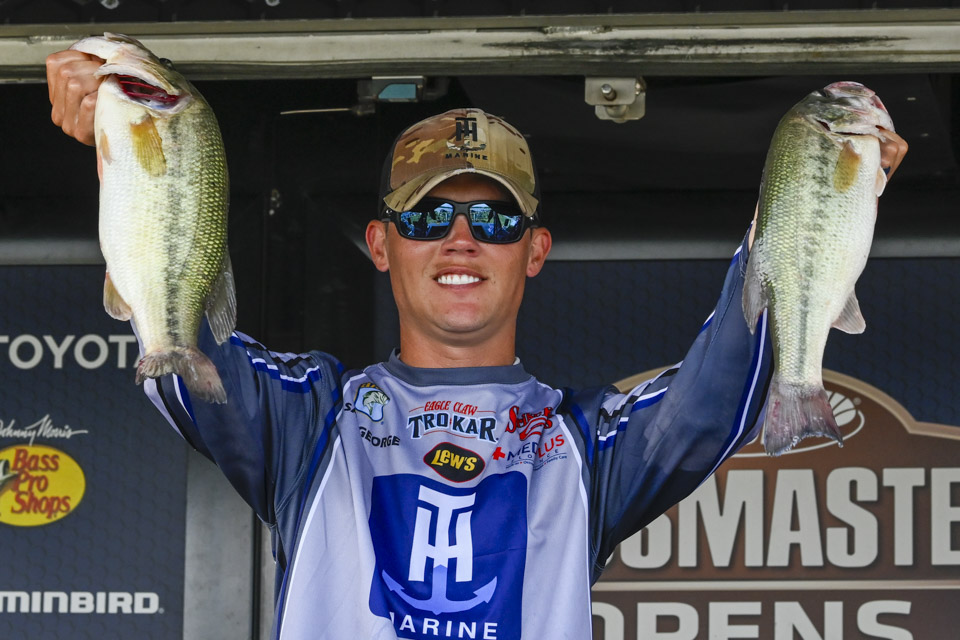
KINGSTON, Tenn. — Bobby Lane Jr. is back in his element. The veteran Florida pro is leading a B.A.S.S. event and doing so by dialing into the intricacies of a vegetation bite that’s in play at the St. Croix Bassmaster Open at Watts Bar.
Lane is literally down in the weeds of a bite that even this master of the grass game is finding a challenge to completely figure out. He wouldn’t have it any other way, given the circumstances.
Lane stopped his interview after weighing 15 pounds, 2 ounces to take the lead in the tournament on Day 1.
“I just want to stop and say how good it feels to be back here, being interviewed again by B.A.S.S.,” said Lane. “I’ve missed it and I want to come back.”
He’s indeed back with much work to be done. In 18 years with B.A.S.S., Lane competed in 15 Bassmaster Classics, won two tournaments and earned 40 Top 10 finishes. Lane is on a quest to return to the Bassmaster Elite Series through the Opens EQ format, while setting another goal to qualify for a Classic. That goal is now in close reach, while the Elite quest remains a possibility. Lane jumped into 13th place in the Opens EQ standings, with the top nine anglers getting invited to the 2024 Elite Series.
Watts Bar’s aquatic weeds are in seasonal maturity. Hydrilla, milfoil and coontail are growing throughout the 39,000-acre impoundment. Too much of a good thing can be bad for bass fishing, especially when you must eliminate a majority of the habitat given the limited fishing time.
That’s where Lane excels with his uncanny ability to eliminate unproductive water (vegetation), determine which of the three types of vegetation are in play (all of them), and then dial into the pattern within the pattern to maximize his success.
Lane didn’t specify those details but clearly, he’s found something different in this otherwise random game of fishing the obvious textbook areas.
What kickstarted the day was an early morning topwater bite in the vegetation, before he moved on to his specialty.
“In late summer and early fall the water is coolest in the early morning, following cooler overnight lows,” Lane said. “That early morning bite is critical because the warmer daytime highs warm the water back up and slow the fish down.”
Lane capitalized on that bite in a key area with a Berkley Swamp Lord and then switched over to soft plastics rigged for probing the vegetation. He planned to duplicate that strategy, while broadening his strike zone to other areas.
Meanwhile, out on the ledges
The grass might be greenest on Watts Bar, but its signature Tennessee River ledges are still hot with an estimated 50% of the anglers favoring that mainstay pattern.
Opens EQ leader JT Thompkins landed in 17th place with 11-13 with an early morning grass bite, followed by a later day session on the ledges.
“The bigger bass disappeared compared to what I found out there in practice,” he said. “It’s a typical deal where I caught a good keeper and that broke up the school.”
Translated in Tennessee River terms, schooling bass holding on bottom ledge structure get wary when caught, causing the school to break up. The wary factor also intensifies after summer-long fishing pressure.
Sam George, a Tennessee River ledge expert from northern Alabama, made a smart move to land in ninth place with 12-13.
“I’m fishing conservative, trying to make this pattern last for two days and get me into the cut on Saturday,” he said. “I caught five and left to save my spot for Friday.”
The plan worked better than planned with George hoping to have caught eight or nine pounds. That also helped move George up to 11th in the Opens EQ standings.
What made it work so well was George’s attention to the size of the gizzard shad appearing on the screen of his forward-facing sonar.
“The areas where I’m fishing have larger-sized shad, and that’s what the bass want on the ledges as summer turns to fall when they are more actively feeding,” he said.
Meanwhile, Tennessean John Garrett, second in Opens EQ and seventh in the tournament with 13-1, scored big on a variation of what he described as running isolated brushpiles.
“You put together a milk run of fishing isolated brushpiles along a shoreline; I’m doing the same thing with isolated hydrilla in deeper water,” Garrett said.
Garrett has about 60 stops on his hydrilla run with the weeds providing concealment for the bass to ambush shad in the surrounding open water, just as a brushpile pattern does on the bank.
What stood out the most yesterday overall was just how important catching a limit is to advance in the Opens EQ standings, or even make a check in the tournament. On the boater side, 61 limits were caught by the 179 pros in the tournament.





